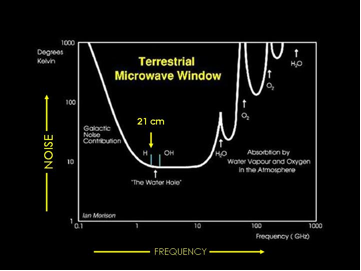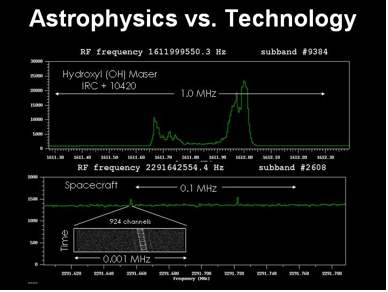The question “are we alone in the universe?” has fascinated people for centuries. In 1959 two Cornell University physicists described how we might answer that question through interstellar communication. Philip Morrison and Guiseppe Cocconi analyzed how two civilizations separated by many light years of space might use electromagnetic radiation to communicate.
Electromagnetic radiation is the general term for the more familiar light and radio waves, but also includes gamma rays, x rays, ultraviolet rays, and infrared. All of these forms of electromagnetic rays or waves travel at the speed of light, the fastest possible speed. The only difference between these types of electromagnetic waves is the length or the wave or the “wavelength.” Since the waves all travel at the speed of light, another way to characterize the wave is by the number of waves received per second. This is the frequency of the wave.
Morrison and Cocconi considered how well the types of electromagnetic waves passed through interstellar space. While space is usually described as a vacuum, it does contain some gas and dust. Over great distances that gas and dust absorb many types of radiation but radio waves pass through nearly unimpeded. For interstellar communication, a particular range of radio frequencies, “microwaves” from 1 GHz to 10 GHz, are particularly good choices. At lower frequencies our galaxy emits prodigious amounts of radio waves creating a loud background of noise. At higher frequencies the Earth’s atmosphere, and presumably the atmosphere of other Earth-like planets, absorbs and emits broad ranges of radio frequencies. The result is a quiet “Microwave Window” through which efficient radio communication is possible.

The Microwave Window has another interesting feature to recommend it as a place for interstellar communication: the “Water Hole.” Some atoms and molecules in space emit radio waves at particular frequencies. Hydrogen atoms emit at 1420 MHz (a wavelength of 21 cm). Hydroxyl molecules, composed of one atom of hydrogen and one atom of oxygen (OH), emit at four specific radio frequencies ranging from 1612 MHz to 1720 MHz. When a hydrogen atom combines with a hydroxyl molecule it forms a molecule of water, the most essential molecule for life as we know it. Thus, the range of frequencies from 1420 to 1720 MHz is called the Water Hole. It has been a popular frequency range for many SETI programs.
While the Microwave Window is a “cosmic quiet zone” the existence of the radio emission lines marking the Water Hole illustrates a problem: distinguishing communication signals from natural astrophysical emission. Most cosmic radio sources as “very broadband.” They “broadcast” over a very wide range of frequencies. For example, the radio emission from a quasar would span most of the diagram above and the amount of power would change very slowly over the frequency range. As mentioned above, hydrogen and hydroxyl emit radio waves at particular frequencies. The diagram below shows the power emitted by a cloud of hydroxyl (OH) molecules near a red giant star. The cloud rotates around the star so some of the molecules are moving toward us and some are moving away. The Doppler Effect shifts the frequency of the radio waves to higher (moving toward us) and lower (moving away) frequencies. The resulting spectrum (power vs. frequency) shows two peaks. These features are very narrow compared to most astrophysical sources.
Signals produced by technology for communication can be much narrower than any known astrophysical source. The bottom half of the diagram shows the spectrum of the signal from the Pioneer 10 spacecraft. The frequency scale has been expanded by nearly a factor of 10. The narrow signal component on the left is further expanded by a factor of 100 to show the very narrow frequency components of the data in the signal. This illustrates a clear way to distinguish extraterrestrial communication signals for astrophysical signals: look for very narrow frequency components. Most SETI programs take this approach, breaking the radio spectrum into many millions of very narrow frequency channels

Where to Look
Searching for extraterrestrial signals can be likened to searching for a gold nugget buried in a field. We have identified the field that we will explore: the Microwave Window in the radio spectrum. We have a way to distinguish the gold nugget for other pieces of metal: look for very narrow bandwidth signals. But, with limited resources (telescope time, electronics, etc.) what is the best strategy to search through the field?
There are two basic strategies. We could examine the entire field but only sift through the top few centimeters of soil. If a gold nugget is near the surface anywhere in the field, we’ll have a good chance of finding it. We could study the chemistry and geology of the surface and select particulars spots where we will dig deep looking for gold. If the gold is buried well below the surface, this strategy has the best chance.
In SETI, there are two basic search strategies. Sky surveys sweep a telescope over large areas of the sky looking for strong signals that may come from any direction. Targeted searches point a telescope at the direction of selected stars. By dwelling on a star for long periods of time, a targeted search is sensitive to weaker signals.
We will pursue both strategies with SETI on the ATA.
